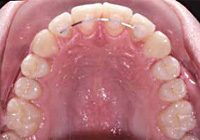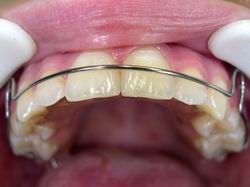Retention period – an essential step of orthodontic treatment.
During orthodontic treatment jaw undergo changes: not only the tooth, but also reconstructed bone, ligaments surrounding the tooth, nerves and blood vessels that feed it change its position. This process is lengthy, and the restructuring continues not only in the active treatment phase (when the apparatus is in the mouth), but some time afterwards. Currently the retention period’s importance is the same as the “wearing-braces” phase of orthodontic treatment. It has been proved that without retainer all the results of the treatment will be reduced to zero, because the abrupt cessation of orthodontic treatment will lead the teeth to return to its original position. To prevent relapse and maintain residual bone and ligaments remodeling orthodontists created retention devices that hold the result.
Retainers can be fixed and removable:
Fixed retention devices represent a stainless steel wire or a fiberglass (CONNECT), firmly and securely fixed to the lingual surface of teeth with fluid photopolymer. Such attachment remains imperceptible, which provides a good cosmetic effect.


Advantages of fixed retainers:
– rapid habituation
– preserve the aesthetics
– do not disturb the function of speech
– do not require special care
– are made directly by the doctor (without the participation of the dental technician) in the short term
– are fixed without teeth preparation
Disadvantages of fixed retainers:
– make the hygiene more difficult
– reduce the tooth mobility and as the result, cause the infringement of the periodontal ligament formation at the end of orthodontic treatment
– promote the deposition of dental plaque in interdental spaces
– in the case of peeling require immediate visit to the doctor
Removable retainers – orthodontic appliances designed for continuous or overnight wear. Mode of their use may be appointed by orthodontist as permanent or temporary.
There are different types of retainers: for one or two jaws, made of plastic, with metal or plastic arcs.



The transparent kappa is also the type of retainer devices.
Advantages of removable retainers:
– fast accustoming
– practically do not disturb the aesthetics
– stabilize the tooth rows in all planes (kappa)
– do not require special care
– can be cleaned easily
– provide gaps’ closure after removal of the rings
Disadvantages of removable retainers:
– close the relatively large area of the hard palate
– can be deformed, can vary in color (when consuming hot drinks)
– unaesthetic (if the presence of vestibular arch)
– cause slight overvaluatin of the height of the bite
– limited use for patients with allergic diseases
Tip: Caring for a removable device is simple. Rinse it under running water after a meal and brush with a toothbrush with toothpaste in the morning and evening brushing.
The choice between removable and fixed retention devices depends on the enamel condition of the teeth, periodontal tissues, duration and rate of obtained orthodontic treatment, face type, gender, age, discipline, and patient preferences.







